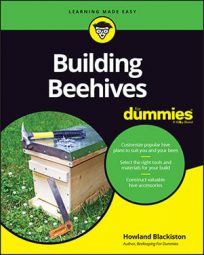If you've decided to build the British National hive, prepare yourself for some fussy cuts on the hand and drip rails for the brood chamber and shallow honey. Read through the cut list tables and the following list and refer to the figures to better understand how to make these cuts. You can make all cuts on your table saw.
-
On each end of each rail, use a 3/4 inch dado blade to cut a 1/2 inch deep rabbet along the designated bottom of each rail.
Do this for the hand rails and the drip rails.
-
Use the 3/4 inch dado blade to cut a 1/2 inch deep rabbet along the designated inside edge of each end of all the rails.
Do this for the hand rails and the drip rails.
-
Use the 3/4 inch dado blade to cut a 1/2 inch deep rabbet along the designated top edge of each end of all the rails.
Do this for the hand rails and the drip rails. As a result of these cuts, you’ll be left with a 3/4 inch x 1/2 inch x 1/2 inch tab centered on the designated outside edge of each rail.
-
For each of the hand rails, cut a rabbet 1/2 inch wide by 15/16 inch deep along the entire length of the designated inside top.
-
For each of the drip rails, use a pencil to make a mark 5/16 inch down from the top outside edge; use this reference to make a beveled cut along the entire top.
The precise angle of this bevel isn’t critical; it just needs to be enough to shed rainwater.
In the following tables, each Material column lists nominal dimensions, and each Dimensions column lists the actual, final measurements.
| Quantity | Material | Dimensions | Notes |
|---|---|---|---|
| 4 | 5/4" x 6" cedar decking | 18-1/8" x 1-1/2" x 1" | Two of these are the upper hand rails and the other two are the lower drip rails. |
| 2 | 1" x 10" cedar | 18-1/8" x 8-7/8" x 3/4" | These are the long sides. Dado a groove at each end, 1" in from the outer edge, 3/4" wide, and 3/8" deep. Cut two notches at both ends, 1/2" from bottom (and top edge), 1/2" wide, and 1/2" deep. |
| 2 | 1" x 10" cedar | 17-3/8" x 8-3/16" x 3/4" | These are the short sides. Rabbet 1/4" wide by 1/2" deep along one entire outside top edge. This becomes the ledge on which the top bar frames sit (frame rest). |
![[Credit: Illustration by Felix Freudzon, Freudzon Design]](https://www.dummies.com/wp-content/uploads/356561.image0.jpg)
| Quantity | Material | Dimensions | Notes |
|---|---|---|---|
| 8 | 5/4" x 6" cedar decking | 18-1/8" x 1-1/2" x 1" | Four of these are the upper hand rails and the other four are the lower drip rails. |
| 4 | 1" x 8" cedar | 18-1/8" x 57/8” x 3/4" | These are the long sides. Dado a groove at each end, 1" in from the outer edge, ¾" wide, and 3/8" deep. Cut notches at both ends, 1/2" from bottom (and top) edge, 1/2" wide, and 1/2" deep. See the preceding figure for details. |
| 4 | 1" x 8" cedar | 17-3/8" x 53/16" x 3/4" | These are the short sides. Rabbet 1/4" wide by 1/2" deep along one entire outside top edge. This becomes the ledge on which the top bar frames sit (frame rest). See the preceding figure for details. |
![[Credit: Illustration by Felix Freudzon, Freudzon Design]](https://www.dummies.com/wp-content/uploads/356562.image1.jpg)
![[Credit: Illustration by Felix Freudzon, Freudzon Design]](https://www.dummies.com/wp-content/uploads/356563.image2.jpg)

